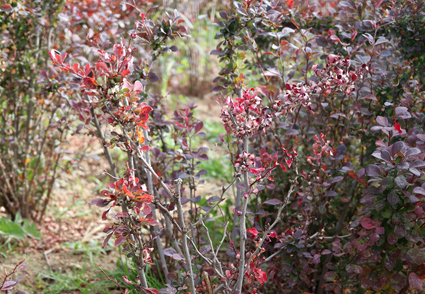Abstract
Several Cytospora species have been identified as pathogens that cause canker diseases. In this study, we examined the causal agent of stem canker on Berberis thunbergii var. atropurpurea in Tibet, China. Three fungal strains were isolated that exhibited morphological characteristics consistent with Cytospora, displaying hyaline and allantoid conidia. Differentiation of species within this genus primarily relies on morphology and molecular data. A new species, Cytospora berberidicola, is introduced based on morphology and molecular data of combined ACT, ITS, RPB2, TEF1 and TUB2 sequences.
References
- Adams, G.C., Roux, J., Wingfield, M.J. & Common, R. (2005) Phylogenetic relationships and morphology of Cytospora species and related teleomorphs (Ascomycota, Diaporthales, Valsaceae) from Eucalyptus. Studies in Mycology 52: 1–144.
- Adams, G.C., Roux, J. & Wingfield, M.J. (2006) Cytospora species (Ascomycota, Diaporthales, Valsaceae), introduced and native pathogens of trees in South Africa. Australasian Plant Pathology 35: 521–548. https://doi.org/10.1071/AP06058
- Alves, A., Crous, P.W., Correia, A. & Phillips, A.J.L. (2008) Morphological and molecular data reveal cryptic speciation in Lasiodiplodia theobromae. Fungal Diversity 28: 1–13.
- Carbone, I. & Kohn, L. (1999) A method for designing primer sets for speciation studies in filamentous ascomycetes. Mycologia 91: 553–556. https://doi.org/10.2307/3761358
- Doyle, J.J. & Doyle, J.L. (1990) Isolation of plant DNA from fresh tissue. Focus 12: 13–15. https://doi.org/10.2307/2419362
- Ehrenberg, C.G. (1818) Sylvae Mycologicae Berolinenses. Formis Theophili Bruschcke, Berlin, Germany.
- Fan, X.L., Hyde, K.D., Liu, M., Liang, Y.M. & Tian, C.M. (2015) Cytospora species associated with walnut canker disease in China, with description of a new species C. gigalocus. Fungal Biology 119: 310–319. https://doi.org/10.1016/j.funbio.2014.12.011
- Fan, X.L., Bezerra, J.D.P., Tian, C.M. & Crous, P.W. (2020) Cytospora (Diaporthales) in China. Persoonia 45: 1–45. https://doi.org/10.3767/persoonia.2020.45.01
- Gao, H., Pan, M., Tian, C.M. & Fan, X.L. (2021) Cytospora and Diaporthe species associated with hazelnut canker and dieback in Beijing, China. Frontiers in Cellular and Infection Microbiology 11. https://doi.org/10.3389/fcimb.2021.664366
- Glass, N.L. & Donaldson, G.C. (1995) Development of primer sets designed for use with the PCR to amplify conserved genes from filamentous ascomycetes. Applied and Environmental Microbiology 61 (4): 1323–1330. https://doi.org/10.1128/aem.61.4.1323-1330.1995
- Katoh, K. & Toh, H. (2010) Parallelization of the MAFFT multiple sequence alignment program. Bioinformatics 26: 1899–1900.
- Lin, L., Pan, M., Tian, C.M. & Fan, X.L. (2022) Fungal richness of Cytospora species associated with willow canker disease in China. Journal of Fungi 8: 377. https://doi.org/10.3390/jof8040377
- Liu, Y.L., Whelen, S. & Hall, B.D. (1999) Phylogenetic relationships among ascomycetes: evidence from an RNA polymerase II subunit. Molecular Biology and Evolution 16: 1799–1808. https://doi.org/10.1093/oxfordjournals.molbev.a026092
- Liu, J.K., Hyde, K.D., Gareth, E.B.G., Ariyawansa, H.A., Bhat, D.J., Boonmee, S., Maharachchikumbura, S., McKenzie, E.H.C., Phookamsak, R., Phukhamsakda, R., Abdel-Wahab, M.A., Buyck, B., Chen, J., Chethana, K.W.T., Singtripop, C., Dai, D.Q., Dai, Y.C., Daranagama, D.A., Dissanayake, A.J., Doliom, M., Fan, L.X., Goonasekara, D., Hirayama, K., Hongsanan, S., Jayasiri, S.C., Jayawardena, R.S., Karunarathna, S.C., Li, W.J., Mapook, A., Norphanphoun, C., Pang, K.L., Perera, R.H., Peršoh, D., Pinruan, U., Senanayake, I.C., Somrithipol, S., Satinee, S., Tanaka, K., Thambugala, K.M., Tian, Q., Tibpromma, S., Udayanga, U., Wijayawardene, N.N., Wanasinghe, D., Abdel-Aziz, F.A., Adamčík, S., Bahkali, A.H., Boonyuen, N., Bulgakov, T., Callac, P., Chomnunti, P., Greiner, K., Hashimoto, A., Hofstetter, V., Kang, J.C., Li, X.H., Liu, Z.Y., Matumura, M., Mortimer, P.E., Rambold, R., Randrianjohany, E., Sato, G., Indrasutdhi, V.S., Verbeken, A., Brackel, W., Wang, Y., Wen, T.C., Xu, J.C., Yan, J.Y., Zhao, R.L. & Camporesi, E. (2015) Fungal diversity notes 1–110: taxonomic and phylogenetic contributions to fungal species. Fungal Diversity 72: 1–197. https://doi.org/10.1007/s13225-015-0324-y
- Palavouzis, S.C., Tzamos, S., Paplomatas, E. & Thomidis, T. (2015) First report of Cytospora punicae isolated from pomegranate plants with symptom of collar rot in northern Greece. Journal of Plant Pathology 97: 209–220.
- Pan, M., Zhu, H.Y., Tian, C.M., Alvarez, L.V. & Fan, X.L. (2018) Cytospora piceae sp. nov. associated with canker disease of Picea crassifolia in China. Phytotaxa 383: 181–196. https://doi.org/10.11646/phytotaxa.383.2.4
- Pan, M., Zhu, H.Y., Bonthond, G., Tain, C.M. & Fan, X.L. (2020) High diversity of Cytospora associated with canker and dieback of Rosaceae in China, with 10 new species described. Frontiers in Plant Science 11: 690. https://doi.org/10.3389/fpls.2020.00690
- Ronquist, F. & Huelsenbeck, J.P. (2003) MrBayes 3: Bayesian phylogenetic inference under mixed models. Bioinformatics 19: 1572–1574. https://doi.org/10.1093/bioinformatics/btg180
- Senanayake, I.C., Crous, P.W., Groenewald, J.Z., Maharachchikumbura, S.S.N., Jeewon, R., Phillips, A.J.L., Bhat, J.D., Perera, R.H., Li, Q.R., Li, W.J., Tangthirasunun, N., Norphanphoun, C., Karunarathna, S.C., Camporesi, E., Manawasighe, I.S., Al-Sadi, A.M. & Hyde, K.D. (2017) Families of Diaporthales based on morphological and phylogenetic evidence. Studies in Mycology 86: 217–296. https://doi.org/10.1016/j.simyco.2017.07.003
- Stamatakis, A. (2014) RAxML version 8: A tool for phylogenetic analysis and post-analysis of large phylogenies. Bioinformatics 30: 312–1313. https://doi.org/10.1093/bioinformatics/btu033
- Tamura, K., Stecher, G., Peterson, D., Filipski, A. & Kumar, S. (2013) MEGA6: molecular evolutionary genetics analysis version 6.0. Molecular Biology and Evolution 30: 2725–2729. https://doi.org/10.1093/molbev/mst197
- Tulasne, L.R. & Tulasne, C. (1863) Selecta Fungorum Carpologia. Vol. X. [Translated by W.B. Grove.] Oxford: Clarendon Press, United States, 126 pp.
- Wang, X.L., Kang, Z.S., Huang, L.L. & Wei, J. (2011) Re-evaluation of pathogens causing Valsa canker on apple in China. Mycologia 103: 317–324. https://doi.org/10.3852/09-165
- Wang, Y.L., Lu, Q., Decock, C., Li, Y.X. & Zhang, X.Y. (2015) Cytospora species from Populus and Salix in China with C. davidiana sp. nov. Fungal Biology 119 (5): 420–432. https://doi.org/10.1016/j.funbio.2015.01.005
- White, T.J., Bruns, T., Lee, S. & Taylor, J. (1990) Amplification and direct sequencing of fungal ribosomal RNA genes for phylogenetics. PCR protocols: a guide to methods and applications 18: 315–322. https://doi.org/10.1016/B978-0-12-372180-8.50042-1
- Yang, Q., Fan, X.L., Crous, P.W, Liang, Y.M. & Tian, C.M. (2015) Cytospora from Ulmus pumila in Northern China. Mycological Progress 14: 1–12. https://doi.org/10.1007/s11557-015-1096-1
- Zhu, H.Y., Pan, M., Bezerra, J.D.P., Tian, C.M. & Fan, X.L. (2020) Discovery of Cytospora species associated with canker disease of tree hosts from Mount Dongling of China. MycoKeys 68: 97–121. https://doi.org/10.3897/mycokeys.62.47854


